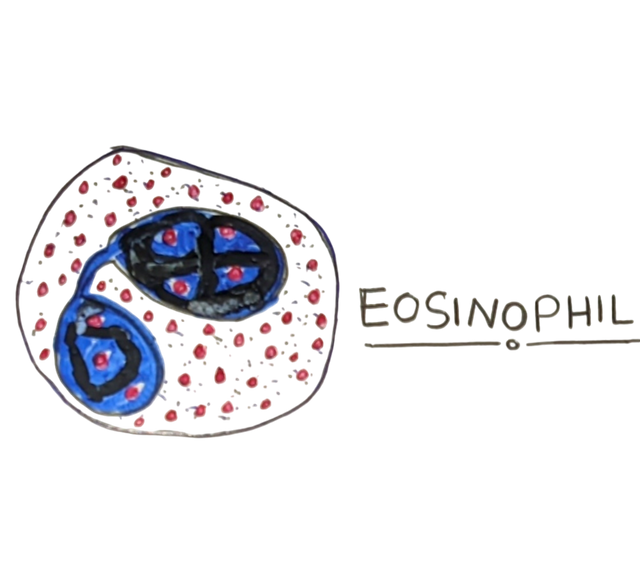
Edited using canva
This topic reminds me of the jamb question that usually confused me back then, not now. I'll review a question that says, Leucocytes do what to the body?
A. Fights bacteria and viruses
B. Builds up blood
C. Prevents food from entering the blood
D. Acts as a tissue that protects the body
I'll become confused with options A and B. Is leucocyte white or red blood cells? I know white blood cells fight bacteria, but is it leucocytes or erythrocytes? Hmmm. I later came to discover a remembrance trick that kept me from such a mistake.
Imagine your body is a state, and inside your body is a city protected by soldiers from intruders and robbers. They work round the clock—ffrom morning till the next morning to attack intruders who want to harm residents of the city. If kept hungry for days, they may lose guard and become weak and incapable of doing their job. Now when robbers attack, the city becomes susceptible and can be very devastating.
This case is similar as the state is our body, the city is the organs, tissues, and systems in our body, and the soldiers serve as the White blood cells which act to boost our system's immunity and protect us from intruders, which include bacteria, viruses, fungi, etc; which can cause temporary and permanent harm that affects our body. If these white blood cells are not fed with antibiotics, they could become weak and susceptible to attacks by these intruders.
Define White Blood Cells |
|---|
White blood cells are known as the body's first security guards that work constantly to recognise viruses, attack them, and protect the body from infection. White blood cells are also known as Leucocytes which form part of the body's immune system and fight to strengthen it by all means.
They are cells that act like soldiers in the body, flowing in the human body's blood and tissues to recognise, fight, and destroy infections. They can be found in the lymphatic system, which are organs like lymph nodes and spleen. The role of these organs is to filter whatever harmful substance or elements enter the body's bloodstream.
They move about freely in check for threats to the body, and they are produced in the bone marrow, a tissue that's spongelike in the bone. They circulate throughout the body from this marrow.

These white blood cells have different forms or types that perform specific functions in the body of an individual. Without these cells in the body, the tissues, organs, and systems would be damaged, which forms part of the level of organisation in living things. Without these cells, the least thing like a cold can be life-threatening and needs antibiotics, fruits, and healthy foods to boost the immunity of the body.
This triggers the white blood cells to remain active. The next question raises types of white blood cells and the functions they all perform in the body for development and prevention of infections. This is a typical white blood cell that accompanies the red blood cells in the blood of an organism. The white blood cell is a major blood component. It has
nucleus
mitochondria
cell walls that protect it
Genetic material known as DNA.
 | White Blood Cell |
|---|
Draw White Blood Cell Series |
|---|
White blood cells are very important for the boost of our immune system and are of various types with various functions. White blood cells are grouped into two types, which includes Granulocytes and Agranulocytes.
One contains granules in their cytoplasm while the other doesn't. These granules contain enzymes that help kill or digest microorganisms that pose a threat, and these are commonly found in granulocytes, as the name implies. These types of white blood cells are classified into three series as shown in the diagram.
Neutrophils |
|---|
- Neutrophils which engulf and destroy bacteria, are the first series to act when the body is threatened. When these cells ingest the pathogen, they die and form pus. This type of series contains 40% plus or white blood cells.
 |  |
|---|
Eosinophils |
|---|
- Eosinophils gas just 2% and fight parasitic infections. They release enzymes that break the walls of parasites, which kill them. This series is largely found with people that have allergic disorders.
 |  |
|---|
Basophils |
|---|
- Basophils contain less than 1% and release enzymes that boost the immune cells when reactions to allergies occur; these fighting parasites too.
 |  |
|---|
The other two are under agranulocytes without visible granules.
Lymphocytes |
|---|
- Lymphocytes kill infected host cells, tumour cells, virus-infected cells, and other pathogens as they produce antibodies for this function.
 |  |
|---|
Monocytes |
|---|
- Monocytes have up to 8% of white blood cells and trigger other immune responses, which aid in the prevention of pathogens attacking the tissues and system.
 |  |
|---|
Neutrophilia Vs Neutropenia |
|---|
Let's use that same illustration we used at the onset of this post. **Let's assume that city we talked about is trying to invade from the gate and lots of soldiers if not all goes out to attack the robbers, majority are liable to die that's if the enemies are much stronger with weapons. This becomes a threat as most soldiers will have to see it as a life and death situation.
Now in a case where there are few soldiers to fight large number of enemies, it becomes a serious problem as the city would be invaded. This explains Neutrophilia and Neutropenia. These two terms forms the basics of a reactive white blood cell called Neutrophils. Neutrophils as the soldiers in this case. When Neutrophils becomes much, it becomes a problem. When it is less, it becomes a problem. How?
We know very well that neutrophils are white blood series that acts first in fighting microorganisms and contains a high number of white blood cells. The levels become imbalanced. When there's an elevated or high number of Neutrophils in the blood of a person, it becomes a serious problem and bring about a condition known as Neutrophilia.

Edited using canva
Neutrophilia
This condition usually shows there's an active response to infection and there are lots of causes for this to happen. When there's acute inflammation such as arthritis, the body triggers and produce this neutrophil in excess.
- Stress, trauma and infections like bacteria and fungi causes this
Are the side effects of excess production of Neutrophils in the blood? Yes there are which includes
- Fatigue or tiredness
- Swelling of a part of the body due to inflammation
- High fever and other infections relative.
To treat this if you're a victim, you can enrich your body with antibiotics for infections and antiinflammatory medicines for inflammation. It's good to visit a doctor who'll detect which is the root cause so he or she can help you tackle it. This is a common case today as most of us have these symptoms but don't know what causes it or the name of the disorder.
Neutropenia
This has to do with when this neutrophil becomes low or is lacking in the blood to defend infections. This is more serious than the later as this can make humans susceptible to attacks by viruses, bacteria etc. Disorders in the bone marrows are a major cause of this medical condition which includes leukemia that is a major disease that affects the bone marrow.
- Infections and disorders relative to immune system attacking the white blood cells series.
- Drugs too can less to reduced levels of neutropenia as well as deficiencies in vitamins like vitamin B12.
Fever, soar throats, frequent infection in the mouth and skin are symptoms of this medical condition. To treat, you must enrich your immune system with antibodies in form of antibiotics that acts to prevent infections. If possible for cases of leukemia, you may need a transplant of bone marrow and other cases.
Explain a case related to the white Series |
|---|
I'll use a case of Neutrophilia, which has high levels of Neutrophils, making an increased production of Neutrophils to fight infections. The body needs enforcement of antibiotics to build up. Now, a common disease associated with this neutrophilia is Pneumonia which is a disease caused by a harmful bacteria entering the lungs and causing obstruction or difficulty in breathing.
Since the levels of neutrophils are high, the infections entering the lungs are being fought gradually. The infection has triggered too many neutrophils, as it has overwhelmed the lungs and then produced mucus or pus, which makes it difficult to breathe freely.

A case as demonstrated in the artworks below shows *Sir Jerry" who is suffering from this medical condition, pneumonia. He is rushed to the hospital and admitted. His was rushed to the hospital because his condition worsened over a period of 4 days, which needed serious emergency attention.
 |  |
|---|
Taken to the hospital and administered, the doctor on duty carried out some physical checks, taking note of his heartbeat, respiratory rate, and oxygen saturation. The doctor, using his stethoscope, observed a common sign of pneumonia in this man and carried out a chest X-ray test.

This man was placed under scan, which showed that his lungs were filled with pus and mucus, making it hard for him to breathe well. Blood tests were carried out, and he found out that he had the medical condition of Neutrophils which his pneumonia triggered the medical condition to act on that infection. Sputum culture was carried out as well.

From the scan, the doctor observed the areas he needed to work on, as he has seen the real causes of the disease. He then advised Sir Jerry to take a spectrum of antibiotics while waiting for confirmation of which type of bacteria is part. If the bacteria are not susceptible to the antibiotics given, he'll have to change his treatment to another form, which could be;

Being placed in supplemental oxygen to help him breathe easily. The doctor also advised him to take pain relief to suit his chest and carry out breathing and chest exercise when he is discharged. He was placed under careful monitoring till every discovery was set to avoid implications that can lead to
respiratory failure
pleural effusion, etc.

After days of close monitoring and treatment, Sir Jerry was given a physical examination, and it was observed by the doctor that his fever has subsided and that his oxygen saturation level has increased and there's a balance in his white blood cells.
He was then discharged and encouraged to take antibiotics to build the antibodies in his body. He was also advised to drink enough water, rest, practice breathing and chest exercises. That was how Sir Jerry left the hospital relieved.

 | case study |
|---|
To those out there having pneumonia and feeling it's a normal cold, you can learn from the advice given by Sir Jerry and practice such to avoid being hospitalised or cases where you'll kick the bucket. Your white blood cells need to be charged to fight for you.
I invite @victorlives, @okere-blessing and @patjewell
Cc,
@dexsyluz
@aaliarubab
Upvoted. Thank You for sending some of your rewards to @null. It will make Steem stronger.
Downvoting a post can decrease pending rewards and make it less visible. Common reasons:
Submit
Downvoting a post can decrease pending rewards and make it less visible. Common reasons:
Submit
https://x.com/bossj23Mod/status/1848279896402927895?t=6JUvyYXyWMGC-VK7yp-pbA&s=19
Downvoting a post can decrease pending rewards and make it less visible. Common reasons:
Submit